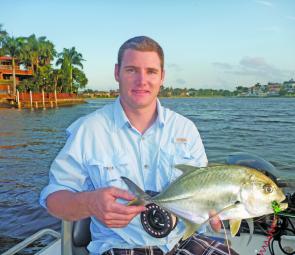There’s no getting away from the disastrous proportions of the Big Wet that enveloped Queensland after Christmas but just as every cloud has a silver lining the South East Queensland fly angler can make the best of the change in water levels and salinity the massive dump of rain has produced.
Rivers, creeks, even canal estates, have had their ecosystems altered yet, if my recent experience with the fly rod in sheltered waters is an indicator, there is some mighty good fly angling to be had.
Canal systems seem to have come alive since the big flush hit them with trevally, great sluggers on fly gear, really coming into their own. Don’t overlook, either, that one of the great pluses when seeking these fish is the possibility of some interesting by catch as well. When seeking trevally it’s by no means unusual to find the fly line in the air while playing a lively tarpon, or maybe the rod straining to capacity from a jack attack.
The habitat is the key to it all, trevally love the upper reaches of rivers and lagoons adjoining such areas just as much as the plentiful canal estates with their rock walls, pontoons and jetties plus the odd deeper corner. All of this structure gives the keen fly rodder a wide scope for some action in largely sheltered waters when there’s wind and rain about.
It’s hard to go past a 7wt or 8wt outfit for this sort of fishing where it’s going to be difficult to predict the size of fish at the business end of the fly line from one cast to the next. Six weight outfits are great fun to use but will be inadequate when that much sought mangrove jack attacks the fly only to head for cover before the angler really comprehends just what is about to happen. Trevally come in such diverse sizes that fish over 50cm in these sheltered waters are not at all uncommon.
What’s more our target species have a death wish when it comes to surface flues such as poppers, which, not surprisingly are my first choice of fly for these fish. They just cannot seem to leave them alone and will attack a skipping popper with enough sight and sound effects to increase the heart rate in seconds. Problem is that poppers need to be fairly large in order to attract a fish in the first place and won’t be easily cast on 6wt gear especially if there’s some breeze about. So a 7wt or 8wt rod with matching floating fly line linked to a rod’s length of tapered leader terminating in at least a 6kg tippet is about right for some serious fun.
You can use any drag equipped reel for so long as there is a bit of backing tucked behind the fly line and the reel is capable of handling some saltwater work. A big trout or bass reel will take care of the task except that it will need some TLC after fishing with a wash down as soon as possible to remove all traces of salt water. It’s a good idea to give the fly line and rod a wash as well!
Poppers I’ve used include the standard cup faced jobs available in virtually any store that sells fly tackle or if you enjoy rolling your own the good old Gartside Gurgler (Google will show the tying) is very hard to beat. Flashy colours on the popper body don’t seem to count for much, it seems far better to have some material streaming behind the 1/0 or 2/0 hook to give the fly a bit of flash at the business end where the hook is.
That little heading sums up the action that’s required when using a popper. The fly needs to have action imparted the second it touches down. In a marked difference to fishing for bass with surface fly, the more action and surface splashing the angler can get into the mix the better things will be. A popper that is literally skipping back towards the angler with decent chugs and bloops as it touches down is the one most likely to see a fish take it in a burst of spay or the classic ‘hole in the water’ implosion. Scary stuff as there’s simply no way of knowing just how large the fish is that has connected, but the strain on the rod arm is usually a pretty quick indicator.
A long cast, rapid stripping of the line with fingers always clamping down on the fly line between strips and then a swift strip/strike to set the hook at the take, that’s the name of this game.
My feeling is that with the weather patterns likely to stay quite unsettled up until autumn there is going to be a lot of scope for some backwater popper action on trevally and their mates. Remember that while a boat is an advantage it’s not mandatory. There are plenty of places, particularly in the canal estates, where bridges will offer quite easy shore based fishing. In rivers and creeks look for steeper banks, backwaters and side waters as good starting locations. The trick is to give it a go and keep plenty of flies and tippet upgrades in the kit. It’s impossible to call just what will grab the fly in the wet season.
Reads: 2544
A selection of poppers for work on trevally and their mates. Note the home made Gartside Gurgler up top. It’s not a fancy fly but it sure works.

Scott Kampe seems pretty chuffed with this fly caught trevally.

Keeping the fly line tight in the fingers between strips is an important part of this technique.

Trevally of this size in the canals and backwaters are great fun on fly and may well be one of the best options in the rain and wind.




